- Military humor
-
Military humor is humor based on stereotypes of military life. Military humor portrays a wide range of characters and situations in the armed forces. It comes in a wide array of cultures and tastes, making use of burlesque, cartoons, comic strips, double entendre, exaggeration, jokes, parody, pranks, ridicule and sarcasm.
Military humor often comes in the form of military jokes or "barrack jokes". Such jokes are not only popular among the military but in all levels of society. Military slang, in any language, is also full of humorous expressions; the term "fart sack" is military slang for a bed or sleeping bag.[1] Barrack humor also often makes use of dysphemism, such as the widespread usage of "shit on a shingle" for chipped beef.[2] Certain military expressions, like friendly fire, are a frequent source of satirical humor.[3]
Notable cartoonists of military humor include Bill Mauldin, Dave Breger, George Baker, Shel Silverstein and Vernon Grant.
Contents
Military jokes
- Military jokes might be sometimes quite blunt, e.g. British soldiers used to make a joke about the Distinguished Service Order (DSO) military decoration, to say of a comrade wounded down the belly that he had received DSO, DSO meaning "Dickie Shot Off."
- In other jokes however, the lack of seriousness is more subtle. Often these are in-jokes and not everyone understands them; e.g., the following reference to "Camouflage Uniform Wear Policies":[4]
- Marines: Work uniform, to be worn only during training and in field situations.
- Army: Will wear it anytime, anywhere.
- Navy: Will not wear camouflage uniforms, they do not camouflage you on a ship. (Ship Captains will make every effort to attempt to explain this to sailors.)
- Air Force: Will defeat the purpose of camouflage uniforms by putting blue and silver chevrons and colorful squadron patches all over them.
- Cadences often contain humorous lyrics, or can be modified to be humorous. Examples:
- My girl's got big ol' hips / Just like two battleships...
- They say that in the Army, the biscuits are mighty fine / One rolled off the table, and killed a friend of mine...
- Sometimes the joke is made by civilians about the military. In the Philippines during President Ferdinand Marcos martial law years, Chief of the Armed Forces General Fabian Ver was a feared figure. In the midst of the tense times, Filipino people used to joke that the general was so fiercely loyal that if Marcos would have ordered him to jump out of the window, General Ver would have saluted and said, "Which floor, sir?"[5]
Comic strips
The best-known comic strip about military life is Mort Walker's long-run Beetle Bailey, set in a United States Army military post where a number of inept characters are stationed. Also notable are George Baker's Sad Sack and Dave Breger's Private Breger. When Roy Crane created the Buz Sawyer Sunday strip, he put the emphasis not on Sawyer but on his comedic sidekick Sweeney.[6]
Military humor in comic books includes the All Select Comics comic book feature "Jeep Jones" by Chic Stone.[7]
Films
Among the oldest military comedies in film are the Flagg and Quirt films. Comedy films about World War II include Buck Privates (1941), Stalag 17 (1953), Mr. Roberts (1955), Kelly's Heroes (1970) and Catch-22 (1970). The film Forrest Gump (1994) offers a glimpse of military humor when portraying Gump as a soldier in training and later fighting in Vietnam.
Television
Some comedies, like the Don't Call Me Charlie (1962-63) TV series (about a young veterinarian drafted into the Army and stationed in Paris), are totally devoted to the military theme. The fourth series of the British sitcom Blackadder, known as Blackadder Goes Forth, revolves around the life of Edmund Blackadder in the trenches of World War I.
Books
 Ballantine Books published Shel Silverstein's 1956 collection of cartoons from Pacific Stars and Stripes.
Ballantine Books published Shel Silverstein's 1956 collection of cartoons from Pacific Stars and Stripes.
Notable books include Shel Silverstein's Grab Your Socks (1956), Jaroslav Hašek's The Good Soldier Švejk (1923) and Catch 22 by Joseph Heller. Reader's Digest's Humor in Uniform (1963) is a collection of short true anecdotes depicting amusing experiences in the armed forces. In 1941, according to editor Harold Hersey, there were about 350 Army camp newspapers. Three years later, when they had expanded to "hundreds and hundreds", he compiled his collection of camp newspapers cartoons, More G.I. Laughs (1944).[8]
In 2002, Hyperion published Kilroy Was Here: The Best American Humor from World War II by Charles Osgood. Publishers Weekly reviewed:
- Originating as a chalked inspection notice in a Quincy, Mass., shipyard, the sketch of bald-headed Kilroy launched a thousand ships and eventually became the most familiar globe-trotting graffiti of World War II... Osgood has assembled a barrage of WWII's amusing essays, stories, jokes, cartoons, poems and short satires. Selections range from heavy artillery (Reader's Digest's "Humor in Uniform" and Bob Hope's I Was There) to the small-arms fire of lesser-known writers. The opening salvo, "A Dictionary of Military Slang: 1941-1944" (compiled from Harold Hersey's More G.I. Laughs and Paris Kendall's Gone with the Draft), is followed by a parade of thematic chapters. Drinking from the same canteens, Osgood repeatedly excerpts from the same handful of mid-1940s publications. Oddly, he ignores the great Dave Breger of the Army weekly Yank, who coined the term G.I. Joe for a cartoon series so popular it ran simultaneously in that outlet and in American newspapers. Osgood offers a half-dozen of Bill Mauldin's famed Willie and Joe cartoons but only a single George Baker Sad Sack strip and one cartoon by the stylish Irwin Caplan, a prolific contributor to the slick postwar magazines.[9]
Magazines
Widely circulated on military bases during the 1950s, Charley Raymond's Charley Jones Laugh Book was an outgrowth of earlier military humor publications. During World War II, Raymond sold Latrine Gazette on Army bases, so successful that he recycled the material into another publication, HEADliners, aimed at Navy men, and then launched Charley Jones Laugh Book as a nationally distributed magazine in 1943. Captain Billy's Whiz Bang began in a similar fashion after World War I.
See also
- 6 Ps
- Fawcett Publications
- Grande Armée slang
- No Time for Sergeants
- Oxymoron
- Russian jokes (section Russian military jokes)
- Republic of Korea Air Force (section Military ranks)
- Saluting trap
- Sergeant Bilko
- "The beatings will continue until morale improves"
- Wipers Times
References
- ^ Fart sack at Sex-lexis
- ^ Chipped beef on toast
- ^ Friendly fire cartoons and comics
- ^ Rod Powers Camouflage Uniform Wear Policies in the US military
- ^ Ken Kashiwahara Aquino's Final Journey. The New York Times 1983
- ^ Famous Artists and Writers, King Features Syndicate, 1949.
- ^ Jeep Jones
- ^ Hersey, Harold. More G.I. Laughs, 1944.
- ^ Publishers Weekly, 2001.
External links
Categories:
Wikimedia Foundation. 2010.

